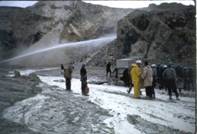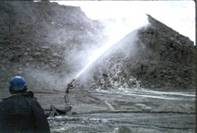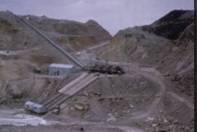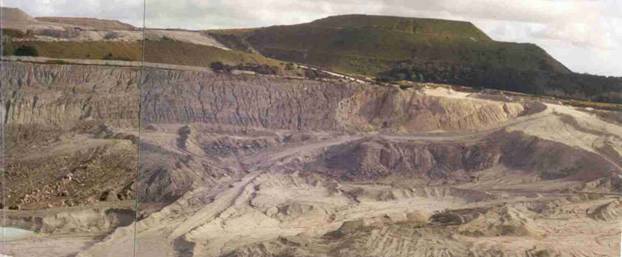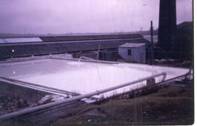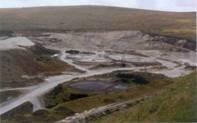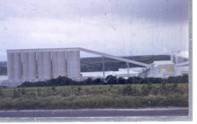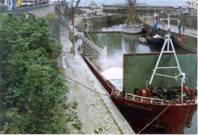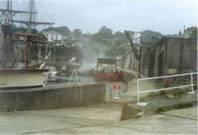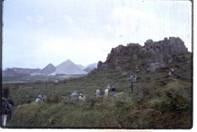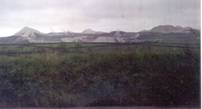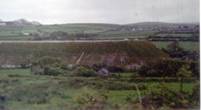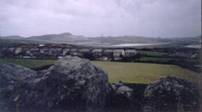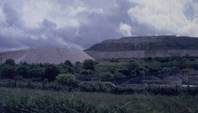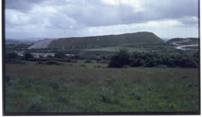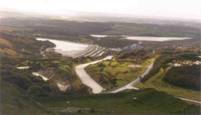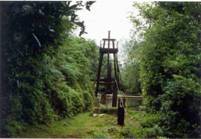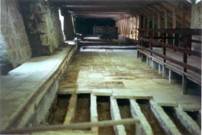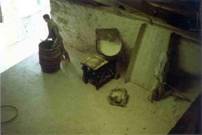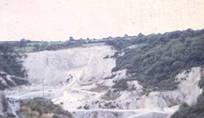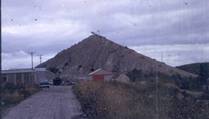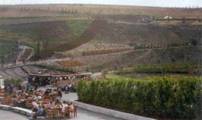
Harrow and Hillingdon Geological Society
China Clay
Home | Monthly Meetings | Field Trips | Exhibitions | Other Activities | Members Pages | Useful Links
The story of china clay
Dr David Brook OBE
INTRODUCTION
China clay (or kaolin as it is known internationally) is a white soft plastic clay mainly composed of kaolinite -- Al4Si4O10(OH)8. The name is derived from Kaoling (now Gaoling) in NE Jiangxi province in China, where it was worked for over 1000 years for the manufacture of fine white porcelain. The composition of Chinese porcelain had been secret but, in the early 18th century, the raw materials used in its manufacture were recognised and deposits were sought in Europe. William Cookworthy (1705-80) recognised their appearance in Cornwall, firstly in the Tregonning-Godolphin Granite in 1746 and subsequently in the St Austell Granite. Until the early 19th century, china clay was used almost exclusively to produce fine ceramics but the development of china clay as a filler in paper-making markedly increased demand, especially in the latter half of 19th century. The introduction of paper coating at the beginning of the 20th century increased demand still further and from about 1914, 75% of total output has been consumed by the paper industry.
ORIGIN
China clay forms by the alteration of feldspathic rocks and deposits may be primary or secondary. Primary deposits formed by alteration in situ of the parent rock by volcanic, hydrothermal or weathering processes. Secondary deposits derive from the erosion of pre-existing deposits and subsequent transport and deposition in a non-marine environment. China clay deposits in south-west England and in South Carolina & Georgia are type localities for primary and secondary deposits.
The granites of south-west England have been affected by post-emplacement alteration. Kaolinite is derived from the decomposition of feldspar, especially plagioclase, with secondary mica as an intermediate phase. Kaolinisation is spatially related to the joint and vein systems in the granites, along which the fluids moved. Kaolinised zones are funnel-shaped or trough-like, narrowing downwards.
UK RESOURCES
The St Austell Granite is extensively kaolinised in its central and western portions over about 2/3 of its 93km2 area. This area is some of the most intensely exploited mineral-bearing land in the UK. It is by far the most important source of UK kaolin with about 85% of total production and a major proportion of the high-brightness, speciality-coating grades.
Kaolinisation in Dartmoor has a restricted distribution, being confined to the south-west edge from Shaugh Moor through Lee Moor to Hemerdon. Kaolin has been worked in Lee Moor since the 1830s and production in the 1980s was about 0.5M tpa.
Bodmin Moor has areas of kaolinisation in the south-west and north-west parts of the granite and it has been worked since 1860. Production ceased in 2001.
Tregonning Hill has intense kaolinisation, first worked in 1746, but it has not produced since the 1st World War. There was also, formerly, a small production from the Carnmenellis Granite at Porkellis Moor and from Belowda Beacon, Carn Marth and Hingston Down. Minor output from the Land's End Granite ceased in 1991.
OVERSEAS RESOURCES
The major world source of kaolin is the Atlantic coastal plain of Georgia and South Carolina (about 90% of US production). Secondary deposits occur as lenses and tabular layers up to 20m thick and covering several km in sediments of Upper Palaeocene to Middle Eocene age and at or near the top of the Upper Cretaceous. US production increased by over 5% per annum between 1960 and 1982 and now stands at just short of 10M tpa.
PROPERTIES & USES
English china clay typically contains 75-85% kaolinite in ceramic grades and up to 94% for paper-coating grades. The most abundant other constituent is mica (5-20%), with small amounts of smectite, quartz, tourmaline and feldspar in ceramic clays. Its fundamental property is whiteness and fine but controllable particle size. Its platy shape increases opacity and it is soft (MOH 2.5), non-abrasive and chemically inert over a wide range of pH.
Kaolin has a wide variety of industrial uses but the most important (70% of UK sales) is in paper-making. Other major outlets are ceramics (22%) and as a filler/extender in paint, rubber, plastics (8%)
Paper In paper, kaolin performs two quite separate functions.
-
as a filler, it reduces overall cost and improves printing properties (37%);
-
as a coating pigment it enhances surface properties – brightness, smoothness and gloss – allowing accurate reproduction of colour printing (33%)
Ceramics Originally used for white-ware ceramics, this remains a major market with almost 1M tpa used in western Europe in vitreous china sanitary ware, tableware, wall tiles (in UK), electrical porcelain & glazes. The clay component contributes to plasticity, workability and strength in the pre-fired state and to strength in fired body
Paint Both natural and calcined kaolin are used as extenders in a range of paint formulations, particularly emulsion paint. It reduces overall cost, increases opacity (and therefore covering power) and prevents pigment settling in the can.
Rubber Kaolin is incorporated in both natural and synthetic rubber compounds. Hard clays (75-80%<2 micron) enhance strength and impart good resistance to wear and abrasion. Soft clays (20-45%<2 microns) lower overall cost without impairing physical properties.
Other applications include:
-
as a filler in plastics (pvc), in white cement, in glass fibre (as a source of Al to improve durability and mechanical strength),
- as an inert carrier for insecticides, pesticides and weed-killers,
- as a carrier for active ingredients in stomach medicines and tablets,
-
in leather, textiles, inks, dyes, adhesives, crayons and pencils, in some toothpastes and some cosmetic applications.
TECHNOLOGY
In the primary deposits of south-west England, no natural concentration has occurred and the kaolin content of the clay matrix is low (10-15%). However, since it is largely within the lower size fraction, processing consists of rejecting coarser materials (quartz and mica) by classification in water to produce a high-grade product >75% kaolinite.
Large volumes of waste are generated – typically 6.5 tonnes sand & stent (waste rock), 1 tonne of overburden and 1 tonne of micaceous residue per tonne of marketable clay. Total waste arisings are 22M tpa, of which about 10M tpa is sand. Some 2Mtpa are sold as aggregate to a largely saturated local market, with small amounts being shipped from Par. The total industry waste stockpile has been estimated at over 600M tonnes.
In contrast the sedimentary kaolins of Georgia have a much higher kaolinite content (>80% as dug)
Mining
China clay is extracted by hydraulic mining following the removal of up to 15m of overburden (weathered granite, peat, soil etc). Kaolinised granite may grade rapidly over <1m into unkaolinised granite (stent), which may need to be blasted and removed by truck and shovel. Slurry gravitates to the base of the pit (sump) from where it is pumped into spiral sand classifiers. Clay fines are carried away in liquid overflow and coarse sand and unaltered granite is discharged to waste. Inclined conveyors remove this waste to tips. Overflow is pumped to primary hydrocyclones, which remove fine quartz and coarse mica in the underflow. This is pumped to mica dams as waste. Overflow is largely kaolinite but with some impurities. It goes to dewatering tanks then to refining tanks (hydroseparators). The product is dewatered by high-pressure filtration and dried to reduce moisture content from about 30% to 10%.
Dry mining was introduced to the Lee Moor area in 2000. This allows more selective extraction using conventional earth-moving equipment and improved yields. Output is put through primary screening to remove oversize with undersize disaggregated by high-pressure water jets and processed as for hydraulic mining output.
Hydraulic mining, Melbur-Meledor pit 1974 |
Hydraulic mining monitor, Melbur- Meledor pit 1974 |
Spiral classifiers & conveyor to tip, Goonbarrow pit 1974 |
Lee moor pit & tips 2004 |
||
White Hill Yeo pit, Lee Moor 2004 |
||
Slurry tanks at Lee Moor 1967 |
Slurry tanks, Churchtown pit, Lee Moor 2004 |
Blackpool Works, dryer & mill, St Austell 1972 |
TRANSPORT
Deliveries to home market are largely by road and rail (328,000 of 341,000 in 1979) but almost 80% of the product is exported through the ports of Par (0.32M tonnes in 2002) and Fowey (1.4m tonnes in 2002), with minor shipments formerly through Charlestown.
PRODUCTION
China clay in south-west England is an internationally important mineral resource. Production began in the mid-18th century. Total output has been estimated to exceed 150M tonnes. The value of production (£237M in 1998 -- now some £200M pa) makes it the most important industrial mineral produced in the UK. The china clay industry also underpins the UK whiteware ceramics industry
UK sales in 2002 were 2.16M tonnes (85% from Cornwall, 15% from Devon), a significant decline from peak sales of 2.78M tonnes in 1988. The industry employs 2,400 people directly and it is the largest private employer in Cornwall. UK consumption declined from 450,000 tonnes in 1990 to 264,000 tonnes in 2002.
In Devon, there are 5 quarries producing 360,000tpa together with associated processing plants with a processing capacity of 450,000tpa. Total operational area is 2,983 acres (1,200Ha). The industry employs 300 people direct + 60 contract employees at any one time (eg drivers, maintenance engineers, specialist services and consultants) and spends £18M pa locally, excluding large capital projects which in a typical year are about £5M. The industry has been an important part of Dartmoor life for more than 170 years and intends to continue, though it has renounced its planning permissions within the Dartmoor National Park. Current operational life of the Dartmoor reserves is 60+ years, but much depends on the continuing availability of tipping space for the waste.
There are 3 producers:
-
Imerys Minerals Ltd (formerly English China Clays) with 85% of output and operations in Cornwall and Devon. It is a subsidiary of Imerys of France, the world's largest kaolin producer with major operations in the USA and Brazil and about 25% of the world market.
- WBB Minerals Ltd, with operations in Devon alone. It is owned by SCR Sibelco of Belgium.
- Goonvean Ltd with small operations in the St Austell Granite.
The UK was the world’s largest producer of kaolin until the 2nd World War, when the USA surpassed it. In 1981, USA and UK contributed 40% and 15% of world production and they still produce about 30% of the 40M tonnes of world production between them. The USA and UK dominate paper-coating clay production with about 4.5M of 15.8M tpa (1982). Brazil recently emerged as a significant producer, with about one third of the total market, but only minor quantities are produced elsewhere. Ceramic and filler-grade production is much more widespread.
OVERSEAS TRADE
UK is the world’s largest exporter of kaolin, with over 80% of UK production exported (almost 50% of world trade in 1981). In 2002, 88% of UK production valued at £187M was exported. Most goes to Western Europe
VISUAL IMPACT
The St Austell china clay area is notable for the impact of china clay working. The “white alps” of Cornwall are visible for miles and within the area the impact of pits and their working are significant. The “island settlements of Roche, Bugle etc are totally surrounded by china clay workings and tips. Land occupancy by the industry in the St Austell area in 1970 totalled 1,862 hectares, about half of which was pits and plant with the other half being tips and mica dams. By 1991, it was 3,035 hectares, an increase of 63%. Around the village of Lee Moor on the edge of the Dartmoor national park there are similar impacts from both workings and tips, though the plant is now largely hidden within the pits.
Loading china clay at Charlestown 1993 |
Loading china clay at Charlestown 1993 |
Roche Rock & china clay tips, St Austell area 1972 |
CHINA CLAY WASTE RESTORATION
For every tonne of china clay, about 9 tonnes of waste are produced comprising 4 tonnes of sand, 2.5 tonnes of stent, 1.5 tonnes of overburden and 1 tonne of micaceous residue. Total industry waste arisings are 22 M tpa, about 10% of which are sold as aggregates. The total industry stockpile of wastes has been estimated at over 600M tonnes. Individual pits have considerable longevity, the kaolin deposits not having been bottomed out, so few are used for waste disposal. The industry has invested considerable amounts into research on revegetating the waste tips to reduce rainwater erosion, which can lead to problems to nearby houses and to reduce the visual impact of the tips. Much of this has been reported in a study for the then Department of the Environment by Wardell Armstrong (Restoration & revegetation of china clay waste materials)
Stent waste -- Stent contains a large proportion of rocks and boulders, which effectively eliminates the use of some surface treatments, such as cultivation, unless significant surface alteration (such as de-stoning) is considered. Waste is tipped in a series of small benches before being bladed into one larger and more gently sloping bench. This rough stent tip face is also blinded with sand prior to hydro-seeding. Access roads and erosion control channels are maintained between each graded bench.
Sand waste -- Raw sand waste comprises almost half the total disposals and tends to show partial separation of material sizes during tipping
Mica dams are usually constructed of sand & stent waste and designed to be semi-permeable. Mica, suspended in water, is discharged to the lagoons where it is left to settle with excess water drained off through the dam. Additional lifts may be constructed on the dam once the lagoon is full to increase storage volumes
Tips in St Austell area 1972 |
Mica dam, St Austell area 1972 |
Waste tips, mica dam & Roche island settlement 1974 |
Lansalan sky tip from Wheal Martin China Clay Museum 1993 |
||
Erosion problems on regraded tip slopes – On machine-regraded slopes, infiltration is often reduced & the risk of surface-water flow is increased. Often, rill-&-gulley erosion develops before the surface can be stabilised by vegetation cover. The need for control measures is likely to increase as more tips are regraded. If uncontrolled, erosion from regraded unvegetated tips can result in heavy silt loads in surface water, which could pollute local water courses. Small settlement ponds have been constructed to remove the silt before water is discharged to stream. Erosion control measures on the tip itself can reduce or remove erosion, so eliminating the need for this type of preventative measure.
|
|
|
Goonbarrow sand & stent tips, St Austell 1987 |
Singlerose sand tip, St Austell 1987 |
Portworthy mica dams, Lee Moor 2001 |
Hydro-seeding -- This technique has been successful in providing a quick vegetation cover to reduce erosion, wind-blow problems and to provide grass cover. In the long term, grass swards alone may not be a sustainable vegetation cover on new waste materials. Grassed slopes of over 15 years of age ( Blackpool) have failed to establish self-sustaining sward so requiring continued application of fertilisers. Sewage sludge, as a source of both nutrients & organic matter, has potential as an aid to developing sustainable soil systems on tips. Liquid sludge is applied to a steep tip face. More appropriate application techniques may need to be developed. Solid sludges can be used on graded tips when machinery access allows incorporation of the material into the waste surface.
Heathland trials -- Successful trials on the re-establishment of heathland have been undertaken on mica waste (Maggie Pie). Trials have also been successful at Lee Moor on raw sand waste. These trials need to be extended to field scale.
Shrub cover on tips -- Very steep tip faces are limited in their use, amenity & tree & shrub cover often being the only long-term option. Rapid initial colonisation by tree lupin has started to die back as a result of aphid attack. Tree lupin is a valuable first coloniser as it fixes nitrogen in the waste. During the periodic die-back, other trees & shrubs may take advantage of the increased nutrient supply & reduced competition, so establishing a more long-term vegetation cover.
Tree trials (Littlejohn) -- To investigate the ability of some species to tolerate exposure, plots have been planted with different species of conifer & alders on very exposed tip faces at Littlejohn.
PRODUCTIVE AFTER-USE OF DISUSED PITS
Good examples of what can be done to improve the situation and return disused pits to beneficial use are provided by the Wheal Martin China Clay Heritage Centre at Carthew and the Eden Project at Bodelva
Wheal Martin China Clay Heritage Centre.
The Museum of china clay site includes 2 old clay works, the Wheal Martyn Works, which started in the 1820s and continued in operation until 1969, when it was replaced by the modern works at Blackpool, and the Gomm pit and its works, which worked from about 1878 to the 1920s. The historic trail illustrates the working of china clay and, more particularly the pumping to the works using a 35ft diameter water wheel and around the works with an 18ft water wheel, with reconstructions of the level from the base of the pump shaft and the incline for disposing of sand waste from the bottom of the pit to the conical sky tips which became such a feature of the area.
The processing of the clay is illustrated in the preservation of the sand and mica drags, settling pits and tanks and the pan kiln or dry, from where clay was thrown over into the linhay for storage until transport was available to take it away to the customer. Display areas in the Linhay cover Plymouth porcelain, china stone quarrying and tools used in the industry and the yard features transport items such as a clay wagon, a 1916 Peerless 4-ton lorry, Lee Moor No. 1 (0-4-0 saddle tank that was used in Devon for 48 years and side-tipping rail wagons.
The Wheal Martyn Nature Trail shows how wildlife can thrive in an altered landscape and how quickly nature can take over when human activity ceases. It includes habitats ranging from heathland to mature beech woods, most of which were once bare industrial scars. An additional walk to the viewing point allows extensive views of the working Greensplat and Wheal Martyn pits, with Greensplat village, overburden tips and the Blackpool, and Gunheath tips and Gunheath tips in the distance.
Greensplat pit, from Wheal Martin China Clay Museum 1993 |
||
Slurry pump powered by 18ft water wheel via flat rods & cable 1993 |
The pan kiln or dry, with 220ft long flues beneath the tiled floor 1993 |
The linhay, 220ft long clay storage & loading area 1993 |
The Eden Project
The Eden Project is built within the old Bodelva china clay pit, 50m deep on a 130-acre site, which was abandoned in the late 20th century. Following earth-moving of 1.8M tonnes in 6 months, the installation of some 2,000 rock anchors to stabilise the slopes and the installation of a 22L/sec water-collection system, the two biomes (Humid Tropics and Warm Temperate) were constructed as the largest conservatories in the world, to celebrate the relationships between plants and people and to be a symbol of what is possible when people put their mind to the challenge of regeneration and restoration. It cost £86M and is still developing, with a third biome ( Tropical Desert) to be constructed in due course. It already receives over 1M visitors pa.
Bodelva china clay pit 1972 |
Bodelva waste tips 1972 |
Bodelva china clay pit 2001 |
General view of biomes of the Eden Project in the old Bodelva china clay pit 2001 |
||
